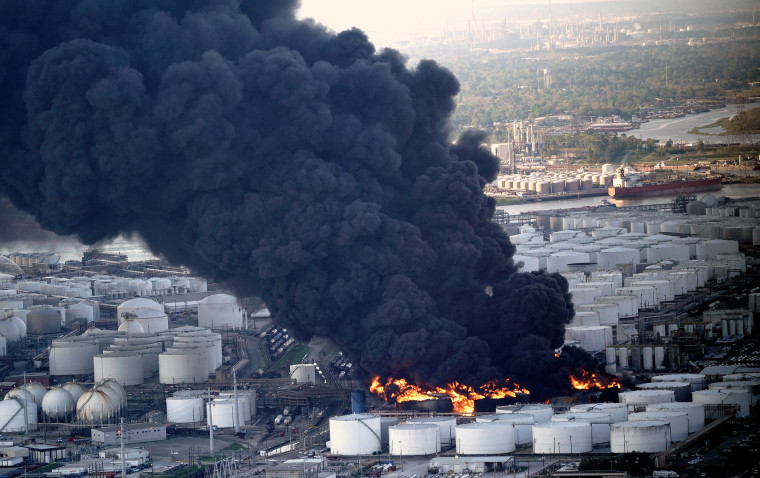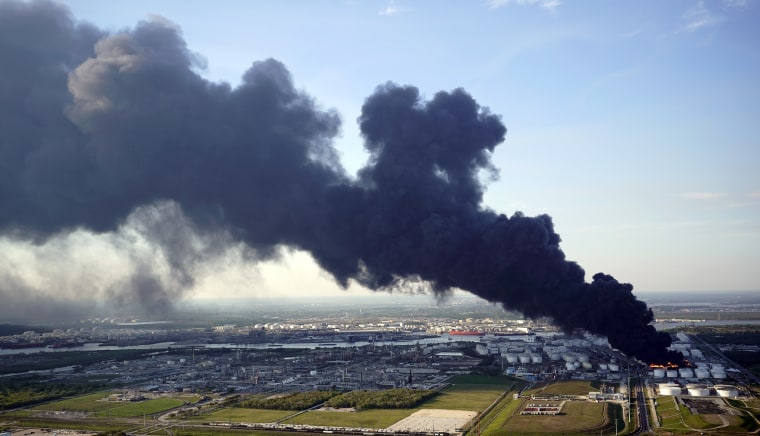HOUSTON — A fire at a Houston-area petrochemical storage site continued to rage late on Monday and is expected to burn for up to two more days, officials said, sending thick black smoke into the air for miles around.
Firefighters were making progress seeking to contain the blaze at Intercontinental Terminals Co (ITC), with the number of giant storage tanks on fire reduced to six from seven earlier, said ITC spokeswoman Alice Richardson.
The blaze at a site along the Houston Ship Channel in Deer Park, Texas, began Sunday when a leak from a tank containing volatile naphtha ignited and spread to others in the same complex, the company said. The tanks hold tens of thousands of barrels of products used to boost gasoline octane, make solvents and plastics.
The blaze has not disrupted nearby refineries or shipping at the country's busiest petrochemical port, authorities said. The Houston Ship Channel is home to nine U.S. oil refineries that process 2.3 million barrels per day (bpd), or 12 percent of the national total.

ITC, which is owned by Japan's Mitsui & Co, reported no injuries among its staff. Nearby residents were encouraged to remain indoors by the city of Deer Park, which lifted a shelter-in-place order for all residents imposed earlier on Monday.
The Texas Commission on Environmental Quality had "not detected any immediate health concerns at ground level" around the plant as of midday Monday. The state was also seeking to bring in a specialized aircraft to monitor emissions at higher altitudes.
The burning tanks held naphtha and xylene, fuels used in gasoline and plastics and toluene - a volatile liquid used to make nail polish remover and paint thinner. Other tanks held base oils commonly used as machine lubricants.
Firefighters were seeking to drain naphtha from one of the tanks to deprive the fire of fuel.
"It's going to be probably two days," said Ray Russell, communications officer for Channel Industries Mutual Aid, which coordinates firefighting departments from Houston Ship Channel plants.
"It's going to have to burn out at the tank," he said at a briefing.
The fire had little effect on the price for regular gasoline delivered on Monday on the Colonial pipeline, which sends fuel from the U.S. Gulf Coast to eastern states.
The naphtha storage tank ignited first from a leak in a pipe, and flames spread to nearby tanks, ITC reported to a Texas regulator on Monday. Its report did not say what caused the leak to catch fire.

School officials in Deer Park, population 32,000, and nearby La Porte, Texas, with about 34,000 residents, suspended classes on Monday and told employees not to report to work.
Tanks containing naphtha and xylene, petrochemicals used to make gasoline and were burning early Monday, ITC officials said.
The six tanks still burning are surrounded by nine other storage tanks within a spill containment dike. Firefighters used a foam fire retardant on nearby tanks to try to limit the fire from spreading.
Ships continued to transit the 50-mile-long channel, which is part of the Port of Houston linking refineries and chemical plants in Houston and Texas City, with the Gulf of Mexico.
"There has been no affect on vessel traffic other than at the two terminals," said J.J. Plunkett, port agent at the Houston Pilots, whose members guide ships in and out of the channel. Ship access to docks at the ITC and Vopak terminals was restricted by the U.S. Coast Guard, he said.
Air emissions tests detected the presence of a volatile organic compound six miles away from the facility. Levels were below those considered hazardous, ITC said.